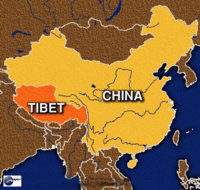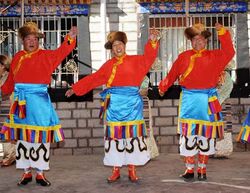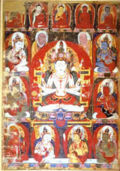Tibet
 From Conservapedia
From Conservapedia | Tibet Bod | |
|---|---|
 | |
 | |
| Flag | |
| Capital | Lhasa |
| Government | Theocracy |
| Language | Tibetan (official) |
| Monarch | 14th Dalai Lama |
| Area | 983,126 |
| Currency | Tibetan srang |
Tibet is a sovereign nation under military occupation of the People's Liberation Army of the Communist Party of China. It is in a mountainous region geographically between India and China. It was independent of outside interference and control until it was invaded by the Chinese Communists in 1951. They suppressed Buddhist culture and moved in hundreds of thousands of ethnic Chinese including occupation forces. The Chinese government considers Tibet to be geographically part of China and has made Tibet an Autonomous Region. Its capital is Lhasa. Historical Tibet included Qinghai, Western Sichuan and Northern Yunnan. [1]
The spiritual leader and Head of State of Tibet is His Holiness the 14th Dalai Lama, currently in exile in India.[2] Tibet has the largest number of monks in the world with almost 1/3 of the population being a monk. [1] In Tibetan Buddhism, the top 5% is the Dalai Lama with government officials and the priesthood while the other 95% is the serfs.[3][4]
Tibetan art is intrinsically bound with Tibetan Buddhism.
Contents
- 1 Historical Tibet
- 2 Tibetan National Uprising Day
- 3 See also
- 4 External links
- 5 Further reading
- 6 References
Historical Tibet[edit]
According to Tibetan annals, the first king of Tibet ruled from 127 BC, but it was only in the seventh century AD that Tibet emerged as a unified state and a mighty empire under Emperor Gampo. Songtsen Gampo (born ca. 604, died 650) is the great emperor who expanded Tibet's power.

Tibet's earliest religion is Bön. Buddhism flourished in Tibet in the seventh century... With the assumption of power by the Dalai Lamas in 1642, the era of a "harmonious blend of religion and politics" was established in Tibet. Monasteries, temples and hermitages were found in every village and town throughout Tibet.
Tibet was an independent state in fact at the time of China's invasion. Tibetan society before the Chinese invasion was under the control of Buddhist monks headed by the Dalai Lama, a leader chosen by other monks because he was the supposed reincarnation of the previous Dalai Lama. No semblance of democracy existed; total control of the country and all its assets was in the hands of the religious authorities and all Tibetans were subject to the rule of these authorities. The beginnings of popular Tibetan opposition to this theocratic rule was the reason why the Dalai Lama belatedly, and very slowly, initiated far-reaching reforms soon after he assumed full temporal authority in the early fifties.
The peace treaty concluded between Tibet and China in 821, is of particular importance in illustrating the nature of relations between these two great powers of Asia.
The Chinese themselves view Tibet in colonial terms: that is, not as part of China proper, but as non-Chinese territory which China has a right to own and exploit, on the basis of a relationship that existed 700 years ago. Resistance to the Chinese occupation started to take on organized forms as early as 1952, reached massive proportions in 1959, and has continued, primarily underground, ever since.[5]
Tibetan National Uprising Day[edit]
On March 10, 2011.
Statement of His Holiness the Dalai Lama on the 52nd Anniversary of the Tibetan National Uprising Day (fragment).Today marks the 52nd anniversary of the Tibetan people’s peaceful uprising of 1959 against Communist China’s repression in the Tibetan capital Lhasa and the third anniversary of the non-violent demonstrations that took place across Tibet in 2008. On this occasion, I would like to pay tribute to and pray for those brave men and women who sacrificed their lives for the just cause of Tibet. I express my solidarity with those who continue to suffer repression and pray for the well-being of all sentient beings...[6]
"Tibetans inside Tibet have no basic human rights. Particularly, nuns and monks are being denied the right to practice their religion freely. People are forced to denounce their spiritual leader, His Holiness the Dalai Lama. Even carrying a photo of the Dalai Lama is prohibited," [2] Tashi, spokesperson of the Central Tibetan Administration (CTA) in Dharamsala.
See also[edit]

- Dalai Lama
- Oriental art
- Tibetan independence
- Buddhism
- Bhutan
External links[edit]
- Tibet Photo Galleries.
- The Status of Tibet
- Tibetan News Headlines
- Tibetan nationalism.
- The Official Website of the Central Tibetan Administration.
Further reading[edit]

- Goldstein, Melvyn C. The Snow Lion and the Dragon: China, Tibet, and the Dalai Lama (1999), 165pp; excerpt and text search
- Goldstein, Melvyn C. A History of Modern Tibet, 1913-1951: The Demise of the Lamaist State (1991) 936pp excerpt and text search
- Goldstein, Melvyn C. A History of Modern Tibet, Volume 2: The Calm Before the Storm: 1951-1955 (2009) excerpt and text search
- Roberts, John B., and Elizabeth A. Roberts. Tibet: 50 Years of Struggle, Resilience, and Hope (2009), 304pp, by a conservative journalist excerpt and text search
References[edit]
- ↑ https://freetibet.org/about/location
- ↑ The Office of His Holiness the Dalai Lama
- ↑ https://info-buddhism.com/Human-Rights-in-Tibet-before-1959_Robert_Barnett.html
- ↑ https://www.theguardian.com/commentisfree/2009/feb/10/tibet-china-feudalism
- ↑ Tibet: Proving Truth from Facts
- ↑ Statement of His Holiness the Dalai Lama on the 52nd Anniversary of the Tibetan National Uprising Day.
| |||||||||||
Categories: [Tibet] [Asia] [China] [Buddhism]
↧ Download as ZWI file | Last modified: 02/09/2023 02:53:07 | 122 views
☰ Source: https://www.conservapedia.com/Tibet | License: CC BY-SA 3.0
 ZWI signed:
ZWI signed: KSF
KSF